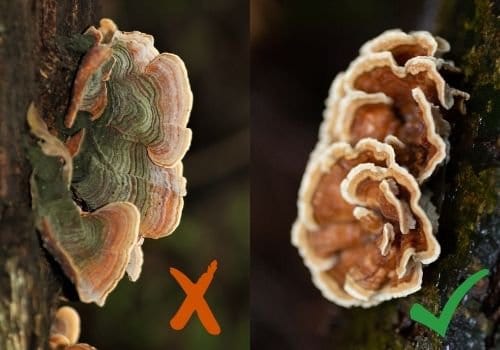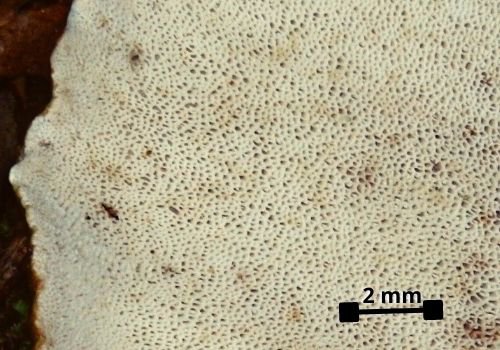The turkey tail mushroom (Trametes versicolor) is a common polypore mushroom found throughout the world. With its colorful, banded caps that vaguely resemble the tail feathers of a turkey, this mushroom is one of the most easily recognizable in the woods. But several lookalike fungi can cause confusion when trying to identify turkey tail.
In this article, you’ll learn exactly what to look for when identifying true turkey tail mushrooms, as well as how to distinguish them from false turkey tails and other imposters With the help of photos and videos, you’ll become an expert at turkey tail mushroom identification in no time!
What Is Turkey Tail?
Turkey tail is a bracket or shelf fungus that grows on dead logs and stumps. Rather than having gills on the underside like typical mushrooms, turkey tail has tiny pores that house its spores. This makes it a polypore mushroom.
The concentrically banded caps of turkey tail form a semicircle or fan shape on the sides of decomposing trees. Fresh caps are thin and pliable with velvety texture. When dried, they become hard and woody.
This mushroom grows prolifically in forests across North America, Europe, Asia, and Australia. It fruits throughout the year in temperate zones but especially flourishes during cool, wet weather.
In addition to being a highly visible and beautiful mushroom, turkey tail has a long history of medicinal use. Modern research has shown it contains polysaccharides that may strengthen the immune system. Turkey tail is also rich in antioxidant pigments.
What Does Turkey Tail Look Like? 4 Key Identification Features
True turkey tail mushrooms can be confidently identified by looking for these 4 characteristics:
- Pores on the underside of the cap
- Bands of colorful concentric zones on the top surface
- A velvety texture on the cap
- Thin, flexible caps when fresh
1. Pores on the Underside
The most important identifying feature of turkey tails is the presence of tiny pores on the underside of the caps rather than gills. These pores appear as small dot-like holes in a white to tan spongy surface.
Closely examine the underside of any mushroom you suspect to be turkey tail. All true turkey tails will have these pores, but lookalikes do not.
2. Colorful Concentric Bands
The caps of turkey tail display unique concentric bands of various colors including shades of brown, yellow, grey, purple, green, and black. The outer edge is always cream or white.
This pattern results from the fungus’ growth over seasons as new pore layers form. The striking multicolor bands are a definite clue that you’ve found true turkey tail.
3. Soft, Velvety Texture
Carefully feel the upper surface of your mushroom. True turkey tails have a distinctly velvety texture resulting from fine hairs that cover the caps.
Some lookalikes like the violet toothed polypore have smoother caps. This velvety nap can help distinguish turkey tail.
4. Thin, Flexible Caps
In its fresh stage, turkey tail mushrooms have caps that are quite thin—just a couple millimeters—and flexible.
You can bend them and they will spring back without breaking. Older specimens become woody and brittle as they dry.
This pliability test can give you even more confidence in your turkey tail ID. Lookalikes often have thicker, more rigid caps.
Common Turkey Tail Lookalikes
While turkey tail mushrooms are relatively easy to identify once you know their key traits, a few imposters can cause misidentification. Here are 3 of the most common turkey tail lookalikes and how to tell them apart:
False Turkey Tail (Stereum ostrea)
Perhaps the most frequent lookalike is the false turkey tail mushroom. Like true turkey tail, it displays colorful concentric bands on its cap and grows in overlapping shelves on wood. However, its underside is smooth and yellowish rather than porous. Algae often grows on false turkey tails as well.
Violet Toothed Polypore (Trichaptum biforme)
This mushroom has pore undersides like turkey tail. But its pores are more sawtooth-like and its caps lack the distinct velvety texture of true turkey tails. Violet toothed polypores usually have purple edges rather than the pale margins of turkey tails too.
Gilled Polypore (Lenzites betulina)
While its common names is misleading, the gilled polypore does not actually have gills. Its white underside is porous like turkey tail but it lacks the thin, flexible texture and concentric coloring. The caps are more orange-cinnamon in color with broad zones rather than intricate bands.
How to Positively Identify Turkey Tail
With so many imposters out there, how can you know for sure if you’ve found true turkey tail mushrooms? Use this checklist for confident identification:
Is the underside porous rather than gilled or smooth?
Does the upper surface have fine hairs making it feel velvety?
Are there colorful concentric bands on the cap?
Is the fresh mushroom thin and pliable?
Only if the answers to all these questions are yes have you found true turkey tail mushrooms rather than a lookalike species. But even then, always double check using multiple field guides if you plan on consuming your foraged mushrooms. When in doubt, throw it out! Proper identification is essential.
Spotting Turkey Tail Mushrooms in the Wild
Once you know what to look for, turkey tail mushrooms are one of the easiest fungi to spot in the forest. Their thin caps and vibrant colors make them stand out on fallen trees and logs.
Turkey tail is extremely widespread—found on every continent except Antarctica. In many areas, it fruits abundantly providing ample opportunities for foragers to harvest them.
In temperate zones like most of North America, you can find turkey tails popping up by late summer and they continue fruiting well into winter—long after gilled mushrooms have ceased fruiting. Cold, rainy fall weather brings ideal conditions for turkey tails.
Slowly walk along trails, scanning the sides of downed trees and stumps. Once you spot a shelf-like mushroom, move off trail and carefully flip it over to inspect the underside and look for true turkey tail characteristics.
Enjoying Your Harvest
Once identified with certainty, turkey tail mushrooms can be enjoyed in several ways:
-
Make a nourishing tea from dried or fresh fungi. Simmer pieces of caps for at least 15 minutes to extract the beneficial compounds. Strain, cool, and drink daily.
-
Add turkey tail powder to smoothies, juices, soups, broths, and more to boost nutritional value.
-
Craft caps into mushrooms shapes using cookie cutters and thread to hang as rustic tree ornaments.
-
Display caps in centerpiece arrangements or framed shadow boxes to showcase their beauty.
-
Dye wool, linen, and other natural fibers using turkey tail mushroom pigments.
With proper identification, the colorful turkey tail mushroom provides abundant opportunities for foraging and creating. Follow the guidance in this article to become skilled at accurately spotting true turkey tails wherever they grow.

Real Versus False Turkey Tail Mushrooms
Turkey tail mushrooms grow abundantly on dead trees and logs in the wild. They are one of the most common forest mushrooms. Turkey’s tail can come in a wide range of colors, and one can look quite different from another.
But it doesn’t end there. Some other wild mushrooms look very much like Trametes versicolor, making things more confusing. These imposters are commonly called “false turkey tail mushrooms” and include Stereum ostrea, Stereum hirstum, and Trichaptum abietinum.

So, how can you tell the difference between “true” and “false” turkey tail mushrooms?
If you come across what looks like Trametes versicolor on your hike, flip the mushroom over. A true turkey tail fungus has visible pores on its white underside, hence why it is classified as a polypore (i.e. many pored) mushroom. Whereas, S. ostrea and S. hirstum have yellow, smooth undersides. You will also commonly find false turkey tail fungi such as S. ostrea mushrooms with algae on them (1).
Turkey Tail Mushroom Identification Checklist
If you can answer “YES” to all the following questions about the mushroom you’re observing, then you’ve found the true turkey tail!
- Are there pores on the underside of your mushroom? See the below for what these should look like.
- Does the top side of the mushroom have very fine hairs, making it velvety to the touch?
- Are there concentric bands of different shades on the top side of the mushroom?
- Is the fresh mushroom thin and flexible? (see the video in the next section)

How to Identify Turkey Tail Mushrooms ( and distinguish from false lookalikes )
FAQ
What does turkey tail do to your body?
Does turkey tail have any toxic look alikes?
How do you identify a turkey tail?
What kind of trees do turkey tails grow on?
